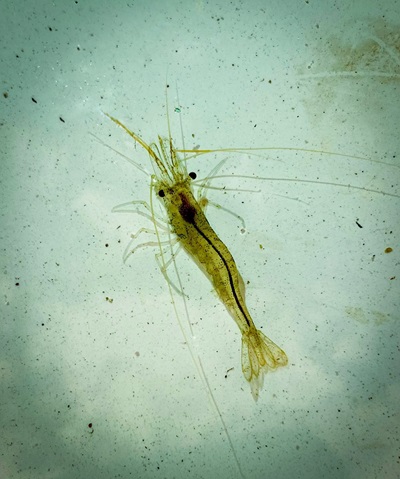Shrimp, Coir Logs, and Willow Wattles
by Jeff Weiss
If you didn't know any better – and really, why would you? – you might think someone had chucked a half-dozen rolls of worn-out carpeting into the Napa River.
I'm going back to late 2018, just after Caltrans Bay Area finished a freshwater shrimp habitat project after replacing the Napa River Bridge on Route 121 in Calistoga.Those carpet rolls are, in fact, coir logs, certainly not something most people - even folks at Caltrans - would know about. About ten feet long and weighing around 500 pounds, the logs are woven from coconut husks and strategically placed in the river to provide refuge for Syncaris Pacifica, the California Freshwater Shrimp.
The shrimp, which are listed as an endangered species under the California Endangered Species Act and the Federal Endangered Species Act, need protection.
"The shrimp are native to Napa, Sonoma, and Marin counties and aren't found in all the waterways'" said Caltrans Biologist, Lauren Ross. They are small, about 1-2 inches, and translucent, which makes them hard to find. There is some evidence that they were abundant enough to be sought after as food for early Native American tribes, but that's hard to verify."
The Coir Logs
Nowadays, the logs, although still quite visible, have biodegraded into something approximating the surrounding riverbank – which was part of the plan. The design indicated that the logs should be staked to the riverbank with willow branches, pruned from local trees, with no more than 25 percent of a tree's canopy cut from an individual tree.
"The goal was to stabilize the bank and create an overhang," said Caltrans Landscape Architect, Chris Padick.
The willow stakes, as expected, have sprouted and grown bushy, well on their way to becoming trees. The combination of coir logs and willows has led the river current to carve an overhanging bank where shrimp can take refuge from predators like salmon, bass, or invasive bullfrogs.
"The goal was to stabilize the bank and create an overhang," said Caltrans Landscape Architect Chris Padick, "a place where willows can grow, and shrimp can hang out. The shrimp love to paddle about in the pools and slow-moving eddies of the Napa River."
Such calm areas are abundant from late spring to early fall, but the rushing water of the rainy season can easily sweep the lightweight shrimp downstream. There is also some evidence that the shrimp can cling to the coir logs as well.
Inventive Plans for Protection
Aside from its remarkable transparency and size, Syncaris Pacifica looks much like its saltwater counterparts.
The freshwater shrimp population had been dwindling for decades from various causes, including habitat loss, global warming, and sedimentation of the streams. Their ability to blend into their surroundings makes them difficult to find and study, leaving many questions about their status unanswered. But that could change as Caltrans and other agencies build more habitats.
When Caltrans designers sat down to develop plans for shrimp habitat, there wasn't much information to draw upon, just some material from the California Fish and Game. Caltrans landscape architects had scratched out preliminary plans when the City of Calistoga approached them. The city had just built its own shrimp habitat and invited Caltrans to use their plans as a guide.
"That changed everything," said Padick. "We liked their plan and redesigned our project using their research and information."
The Caltrans contractor had leeway as to how to implement the design. But again, there weren't many shrimp habitat projects to study. The contractor also needed to find materials which was a challenge given that nearby material yards weren’t exactly brimming with coconut husks for weaving coir logs.
While the literature on freshwater shrimp is thin, we know a few of their behaviors, including that they like to swim near the surface. Knowing this and understanding that the river rises and falls according to the vicissitudes of the rainy and dry seasons, the architects' plans called for the coir logs to be staked down on varying levels of the bank, like terraced houses on a Greek island. The staggered living spaces allow the shrimp to find suitably calm waters throughout the year.
"Caltrans installed the coir logs and willow stakes, upstream and downstream of the bridge," said Padick, "and landscaped the southeast bank." This bank, although designed as habitat, can't help but be a boon to Calistoga's outdoor dining scene alongside the Napa River Bridge. Located at the north end of the Napa Valley, Calistoga is a much-visited wine country town with an attractive, walkable downtown. Caltrans designed the bridge with overlooks to encourage people to stop and enjoy the views of the river.
Helping the shrimp has much improved the function and beauty of the riparian environment. And almost five years later, the area has become woodsy enough that a beaver frequents the area, no doubt intrigued by all the new growth.
Llano Road
To the southwest, in Sonoma County, Caltrans is engaged in another habitat protection project for the freshwater shrimp at the Llano Road Bridge. Several years ago, Caltrans replaced an old culvert with a soft-bottomed bridge, and now that the bridge is finished, workers are improving the surrounding habitat for freshwater shrimp.
Currents sweep through the area during the rainy months, but nothing as swift and forceful as the Napa River. In the dryer months, the site is more of a wetland. So, nothing as robust as coir logs are needed at the site.
"We are using willow wattles instead of coir logs," said biologist, Rebecca Carlson. "They are bunches of willow branches tied together and used for erosion control and shrimp habitat."
Another Caltrans project that includes freshwater shrimp habitat construction will begin in southern Napa at Huichica Creek next to State Route 12.
With one project finished and two more on the way, it seems the California Freshwater Shrimp are finally getting the protection they deserve.





